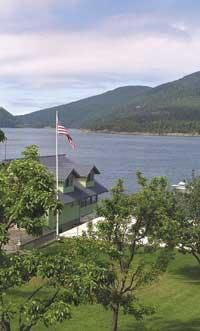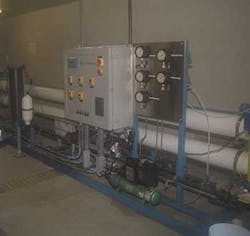Reverse osmosis solves island water quality problem
By Craig Beckman
The Guemes Island community in Skagit County, Washington, USA, uses a reverse osmosis system to produce pure and safe water for residents
Since 1791, Guemes Island, part of the San Juan Islands off Anacortes, Washington, has given residents and visitors an escape from the hustle and bustle of city life, but this escape was not to a deserted island. Rather, the island strived to give residents modern day comforts. While this goal has remained constant for many years, the means of providing residents with mainland accommodations has presented challenges to island officials — particularly a deteriorating potable water supply.
Over the years, the community's 32 residents relied on a local well to provide them with fresh drinking water; however mineral content increased and seawater infiltrated the well, making the water unsuitable for drinking. Poor water quality forced residents to meet their own potable water needs by bringing water to the island by ferry.
Contributing to the water's marginal quality was the naturally occurring high level of dissolved solids – namely salt and iron – in the residential water supply.
Guemes Island property owners turned to the Public Utility District of Skagit County, to solve their water quality problem. The district selected the US consulting firm Kennedy-Jenks of Bellevue, Washington, to help determine the best course of action. The primary goal was to design a treatment system capable of providing residents with a reliable, clean, safe drinking water source. This would require installing a system that reduced the level of dissolved solids below 500 ppm while meeting the daily water supply of 2,000 to 15,000 gallons. The system had to be affordable because the population is small and the cost to purify the water is passed down to residents.
District officials decided that a MUNI reverse osmosis (RO) system from the US company of Osmonics, based in Minnetonka, Minnesota, would meet project goals. Operating costs are lower because the low recovery RO unit uses a limited amount of chemicals to pre-treat water. The RO system's low conversion rate produces a low-concentration brine discharge, which is safer for the environment.
Installing the system on the island, however, presented some challenges. Guemes Island only had a single-phase power source because of its small size. To generate enough power to run the 50-hp RO feed pump meant that the district would have to convert the plant's power source to three-phase. Instead, an inverter system was installed that uses a variable speed motor drive for the high-pressure pump.
In addition, a well had to be drilled to bring seawater from Puget Sound to the island. The unusual shore consisted of condensed sand, so drilling a well on the shoreline was not an option. Alternatively, engineers installed a lateral gallery pipe system in the sand on the shore that connected to the collection well on the beach. This required the installation of an 80-foot perforated pipe that allows salt water to seep into the well. As the water moves from the channel to the pipe, the sand on the shore acts as an effective pre-filter helping to further reduce total project costs. From there, water is pumped into a supply pipe and up the hill to the desalination plant.
The desalination system treats seawater with multi-media sand filtration, followed by an Osmonics Hytrex cartridge filter, before reaching the RO unit. The RO system then desalinates water using a high-pressure RO membrane separation process, turning salty seawater into high-purity water with less than 200 ppm of total dissolved solids.
Ultrapure desalinated water can corrode distribution system pipes and plumbing components. Therefore, it flows into a mineral calcite contact tank before being sent to the distribution system. The treatment process adds calcium hardness, raises pH and stabilises product water by using crushed limestone, which reduces the corrosive nature and improves the overall taste of the water.
After four years of consistant results from the RO equipment, the membranes in the RO unit have not been replaced. In addition, the automated control system requires only one operator to periodically monitor the system.
Author's note
Craig Beckman is the business and marketing manager of Pure Water Systems, Osmonics, with headquarters in Minnetonka, Minnesota.


